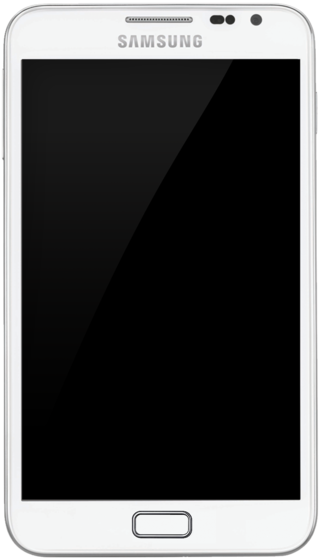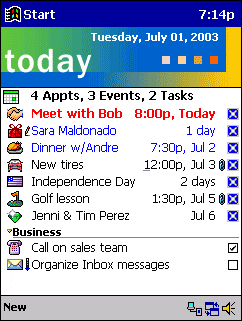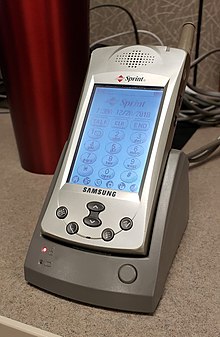
A personal digital assistant (PDA), also known as a handheld PC, is a multi-purpose mobile device which functions as a personal information manager. PDAs have been mostly displaced by the widespread adoption of highly capable smartphones, in particular those based on iOS and Android, and thus saw a rapid decline in use after 2007.

Palm OS was a mobile operating system initially developed by Palm, Inc., for personal digital assistants (PDAs) in 1996. Palm OS was designed for ease of use with a touchscreen-based graphical user interface. It was provided with a suite of basic applications for personal information management. Later versions of the OS were extended to support smartphones. The software appeared on the company's line of Palm devices while several other licensees have manufactured devices powered by Palm OS.

A Pocket PC is a class of personal digital assistant (PDA) that runs the Windows Mobile or Windows Embedded Compact operating system that has some of the abilities of modern desktop PCs. The name was introduced by Microsoft in 2000 as a rebranding of the Palm-size PC category. Some of these devices also had integrated phone and data capabilities, which were called Pocket PC Phone Edition. Windows "Smartphone" is another Windows CE based platform for non-touch flip phones or dumber phones.

Palm, Inc., was an American company that specialized in manufacturing personal digital assistants (PDAs) and developing software. Palm designed the PalmPilot, the first PDA successfully marketed worldwide, and was known for the Treo 600, one of the earlier successful smartphones. Palm developed the Palm OS software for PDAs and smartphones released under its line of Palm-branded devices and also licensed to other PDA manufacturers.

Palm is a line of personal digital assistants (PDAs) and mobile phones developed by California-based Palm, Inc., originally called Palm Computing, Inc. Palm devices are often remembered as "the first wildly popular handheld computers," responsible for ushering in the smartphone era.

A smartphone is a mobile device that combines the functionality of a traditional mobile phone with advanced computing capabilities. It typically has a touchscreen interface, allowing users to access a wide range of applications and services, such as web browsing, email, and social media, as well as multimedia playback and streaming. Smartphones have built-in cameras, GPS navigation, and support for various communication methods, including voice calls, text messaging, and internet-based messaging apps.
The Samsung SPH-i550 smartphone is the Palm OS-based planned successor to the clamshell style SPH-i500. The SPH-i550 has a 320 x 320 internal screen and an external OLED display. The camera takes 1 MP stills and can record video. A built-in MP3 player is controlled by external buttons without having to open the phone.

Pocket Viewer was a model range of personal digital assistants (PDAs) developed by Casio around the turn of the 21st Century.

The Kyocera QCP-6035 was one of the first smartphones to appear in the American market, released in January 2001, one of the first devices to combine a PDA with a mobile phone. Its predecessor was the Qualcomm pdQ released in 1999, built by Qualcomm's handset division, which Kyocera acquired in 2000.
The Samsung SPH-i500 was a Palm OS-based smartphone manufactured by Samsung Electronics. It was previewed at CommunicAsia 2002 in June and launched later that year. It was later discontinued in August 2005. It was marketed in the United States for use on Sprint's mobile phone network.

Windows Mobile is a discontinued mobile operating system developed by Microsoft for smartphones and personal digital assistants.
Handmark Inc. was an American developer and distributor of mobile content, based in Kansas City, Missouri. The company was created in 2000 by the merger of Mobile Generation Software with Palmspring Software.
A mobile operating system is an operating system used for smartphones, tablets, smartwatches, smartglasses, or other non-laptop personal mobile computing devices. While computers such as typical/mobile laptops are "mobile", the operating systems used on them are generally not considered mobile, as they were originally designed for desktop computers that historically did not have or need specific mobile features. This line distinguishing mobile and other forms has become blurred in recent years, due to the fact that newer devices have become smaller and more mobile unlike hardware of the past. Key notabilities blurring this line are the introduction of tablet computers, light-weight laptops, and the hybridization of the two in 2-in-1 PCs.

The Samsung Moment, known as SPH-M900, is a smartphone manufactured by Samsung that uses the open source Android operating system.

The Nexus S is a smartphone co-developed by Google and Samsung and manufactured by Samsung Electronics for release in 2010. It was the first smartphone to use the Android 2.3 "Gingerbread" operating system, and the first Android device to support Near Field Communication (NFC) in both hardware and software.
An app store, also called an app marketplace or app catalog, is a type of digital distribution platform for computer software called applications, often in a mobile context. Apps provide a specific set of functions which, by definition, do not include the running of the computer itself. Complex software designed for use on a personal computer, for example, may have a related app designed for use on a mobile device. Today apps are normally designed to run on a specific operating system—such as the contemporary iOS, macOS, Windows, Linux or Android—but in the past mobile carriers had their own portals for apps and related media content.

The Samsung Galaxy Note is an Android smartphone produced by Samsung Electronics. It was unveiled at IFA Berlin 2011 and first released in Germany in late October 2011, with other countries following afterwards. The Galaxy Note was distinguished by its unusually large form factor—later referred to using the term "phablet"—which straddled the size of the average smartphone at the time, and that of a small tablet: it features a 5.3-inch display, and is bundled with a stylus branded as the "S Pen", which can be used to navigate the device's user interface, and write or draw in supported apps.

Pocket PC 2000 was the first member of the Windows Mobile family of mobile operating systems that was released on April 19, 2000, and was based on Windows CE 3.0. It is the successor to the operating system aboard Palm-size PCs. Backwards compatibility was retained with such Palm-size PC applications.












